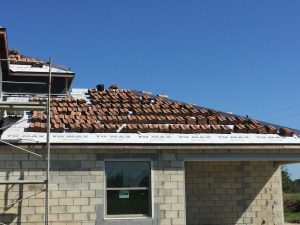With recent hurricanes and high wind speeds drastically affecting the United States, the Tile Roofing Institute (TRI), one of the leading experts in the tile roofing industry, has been asked to comment on the practice of banding tiles on roofs during a high wind event. The TRI President and Technical Director, Rick Olson, responds, providing guidance for roofing contractors and local building officials to consider.
1. Wind events provide both sustained and gusty winds that make it hard to predict the performance of any recommendations for roof loaded concrete and clay tiles or any other claddings. The wind direction, duration and height above the ground will factor into the performance issues of any materials.
2. While the TRI has not conducted any formal wind testing of tiles that are banded, the ability to help improve the ability to stay on the roof would be increased by banding tiles into stacks of multiple tiles.
 3. Most tiles are stacked on roofs during roof loading in stacks of 6-8 tiles. This will provide about 60-80 lbs. per stack that when banded, would provide a greater opportunity to stay in place than individual tiles. This would also allow a faster method of banding by not requiring the re-stacking of tiles into greater heights. Too high a stack might create the opportunity to tip over during peak gusts, or on steeper slopes compared to the 6-8 tiles.
3. Most tiles are stacked on roofs during roof loading in stacks of 6-8 tiles. This will provide about 60-80 lbs. per stack that when banded, would provide a greater opportunity to stay in place than individual tiles. This would also allow a faster method of banding by not requiring the re-stacking of tiles into greater heights. Too high a stack might create the opportunity to tip over during peak gusts, or on steeper slopes compared to the 6-8 tiles.
4. The banding of the tile stacks would help reduce the sliding (cascading) of tiles from stacks downslope that could create additional stacks to slide.
5. Removing tiles from the roof is an expensive and time-consuming practice with no proven advantage over banding the tile stacks on the roof. There has been no full analysis as to what pattern of ground storage or placement would be effective for loose stacked tiles so the likelihood of banding might still need to be considered. Given the duress and time constraints surrounding this activity, it would seem more efficient to band the tiles in place on the roof.
It is important to note that local building officials will always have the final say on the requirements within a jurisdiction. The TRI’s analysis of wind events has shown the banding of tiles on the roof top can reduce risk of damage from loose tiles during wind events.
If you have any questions regarding concrete roof tile or installations, you can visit the Tile Roofing Institute’s website at www.tileroofing.org. Please feel free to contact your local Eagle Account Representative with questions or visit our website at www.eagleroofing.eagl.staging.findsomewinmore.com.
